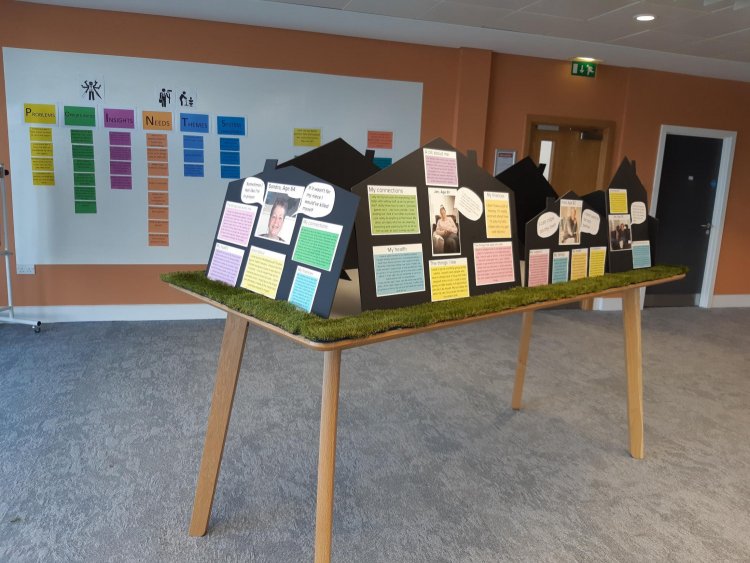- Find a home
-
Customers
- Welcome to Thirteen
- Frequently Asked Questions
- My Thirteen site
- Paying rent and charges
- Report it
- Find out
- Building safety
- Advice and support
- Regeneration and communities
- Leaseholders and shared ownership
-
Services
- Housing for vulnerable and older people
- Care and support
- Homelessness support
- Employment support
- Domestic abuse support
- Mental health support
- Support for ex-offenders
- Get involved
- News
- About us
- Jobs
- Contact us
The Living Well Exhibition Round Up
Michelle Dawson, Innovation Manager, reveals the key findings from our recent Living Well exhibition

12/07/2022
How can we support our customers to live well for longer? This was the question we posed at the beginning of our Living Well journey over a year ago. It’s a big question, and we knew we were going to have to work hard to break it down and turn it into strands of design that help make a real difference to our customers.
A year after starting in my role as Innovation Manager, we have just come to the end of a three-week external exhibition of our learning so far, and for the team, this was the real test. Was our discovery relevant to our external stakeholders? Could we create activity that helped to move forward collaboration and generate new ideas to help solve some of our biggest problems? Would anyone even turn up?
At times it felt indulgent to be spending so much time designing resources and finding creative ways to tell our Living Well discovery story. When everyone is so busy getting on with the day job, figuring out how to stage a mock living room in our office felt a bit tokenistic. As we grappled with trying to get our plotter to print out giant colourful infographics and figured out how to design a ‘priorities’ dart board that our colleagues could stick things to, we did question whether it was all going to be worth it. But actually, in the three weeks we spent walking our most valued stakeholders around our learning, we learned absolutely loads from them in return. Some of the key things we have taken away from the exhibition are:
Collaboration exposes useful patterns and themes. We discovered repeated themes around the prevalence of 50–65-year-olds with complex needs presenting to different local services. We discovered we were on a similar digital journey to our colleagues in local authorities and we discovered we could piggyback onto digital inclusion research already being undertaken by a local primary care network. We unearthed themes about the barriers to customers living in adapted homes and the need for more accessible handy persons services. Most importantly, our external colleagues recognised our Personas as representative of the people they meet in their day-to-day work, which repeatedly highlighted the importance of designing with our shared customers at the centre.
By the end of the three-week exhibition our external colleagues have helped us turn big questions into tangible strands of work that we can now drive forwards. Which made every second of preparation worth it.
- Everyone appreciates the opportunity to reflect and collaborate. We had busy teams of health staff, GPs and Social Care colleagues feeding back how valuable it is to spend time thinking about the bigger picture, the future and how we can all work better together. All the time and effort we put into designing the exhibition was definitely worthwhile.
- Preventative Community Approaches topped the list of most talked about solutions. We talked about falls prevention, fuel poverty, isolation and loneliness, home safety, fear of crime and living with long term health conditions, but the solutions always came back to investing more in preventative approaches embedded in communities. Difficult to measure, difficult to fund and hard to prove return on investment, yet still up there on everyone’s list of things we should spend more money on.
- Everyone is firefighting. There is a recognition that we need radical approaches to integration, joint working and place-based solutions as our local population ages and the prevalence of long-term health conditions like dementia, COPD and diabetes increases year on year. But the services in place to provide solutions are already overwhelmed. More than ever, we need innovative solutions that transcend our previous attempts to improve the systems in which people get lost.
- Collaboration exposes useful patterns and themes. We discovered repeated themes around the prevalence of 50–65-year-olds with complex needs presenting to different local services. We discovered we were on a similar digital journey to our colleagues in local authorities and we discovered we could piggyback onto digital inclusion research already being undertaken by a local primary care network. We unearthed themes about the barriers to customers living in adapted homes and the need for more accessible handy persons services. Most importantly, our external colleagues recognised our Personas as representative of the people they meet in their day-to-day work, which repeatedly highlighted the importance of designing with our shared customers at the centre.
By the end of the three-week exhibition our external colleagues have helped us turn big questions into tangible strands of work that we can now drive forwards. Which made every second of preparation worth it.






